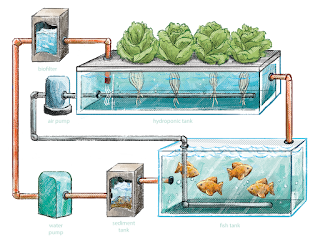Sunday, February 2, 2025
Energy Efficient Aquaponics Setup Ideas For Savings
Energy-Efficient Aquaponics System Design for Optimized Resource Utilization and Cost Savings
Aquaponics, the symbiotic integration of aquaculture (raising fish) and hydroponics (growing plants without soil), offers a sustainable and productive food production method. However, energy consumption can be a significant factor influencing the overall cost-effectiveness of an aquaponics system. This article explores various strategies for designing and operating energy-efficient aquaponics setups, focusing on minimizing energy expenditure while maximizing yield and resource utilization.
Optimizing System Design for Reduced Energy Consumption
The foundation of an energy-efficient aquaponics system lies in careful planning and design. Several key aspects contribute to minimizing energy use throughout the system's operational lifespan.
1. System Location and Orientation: Harnessing Natural Resources
Strategic system placement can significantly reduce energy demands. Optimal sunlight exposure minimizes the need for supplemental lighting in plant growth areas. South-facing systems (in the Northern Hemisphere) benefit from maximum solar radiation. Careful consideration should also be given to ambient temperature. Positioning the system in a sheltered location reduces temperature fluctuations, minimizing the energy required for heating or cooling. This reduces reliance on energy-intensive climate control systems.
2. Water Management: Reducing Pumping and Filtration Needs
Water circulation is crucial in aquaponics, but excessive pumping consumes significant energy. Minimizing the distance water needs to travel between the fish tank, grow beds, and other system components reduces energy expenditure. The use of gravity-fed systems wherever feasible is a highly energy-efficient approach. Efficient pump selection is critical. High-efficiency pumps with low power consumption should be prioritized. Regularly cleaning and maintaining pumps to prevent clogging also optimizes their performance and prolongs their lifespan.
Effective filtration is crucial for maintaining water quality, but overly complex or energy-intensive filtration systems should be avoided. A well-designed system incorporating biofiltration (using beneficial bacteria to break down waste) and mechanical filtration (removing larger solids) can significantly reduce the need for energy-intensive mechanical filtration methods.
3. Insulation and Thermal Management: Minimizing Climate Control Energy
Fluctuations in ambient temperature can significantly impact system performance and energy consumption. Insulating the system components, particularly the fish tank and grow beds, helps maintain a stable temperature, reducing the energy required for heating or cooling. Materials such as foam insulation or recycled materials can be used to insulate the system effectively and minimize heat loss or gain. The use of passive solar heating or cooling techniques can further enhance energy efficiency.
4. Choosing Appropriate Lighting: Optimizing Plant Growth with Minimal Energy
Supplemental lighting is often necessary, especially in environments with limited sunlight. However, the type of lighting selected greatly affects energy consumption. LED grow lights are considerably more energy-efficient than traditional fluorescent or high-pressure sodium lamps. Additionally, careful consideration of the light spectrum and intensity required by the chosen plants can optimize growth while reducing unnecessary energy use.
Integrating Renewable Energy Sources: Sustainable Power Solutions
The integration of renewable energy sources can dramatically reduce the environmental impact and operating costs of an aquaponics system. Several options are available, each with its own set of advantages and limitations.
1. Solar Energy: Harnessing the Sun's Power
Solar panels can provide a clean and renewable energy source for powering the aquaponics system. Photovoltaic (PV) panels convert sunlight directly into electricity, eliminating the need for grid power. The size of the solar array will depend on the system's energy requirements and the amount of available sunlight. Battery storage can be integrated to ensure a continuous power supply, even during periods of low sunlight.
2. Wind Energy: Utilizing Wind Power for System Operation
In areas with consistent wind, wind turbines can be a viable option for generating electricity to power the aquaponics system. The size and capacity of the turbine will depend on the average wind speed and the system's energy demand. However, wind energy is often less reliable than solar energy, and appropriate backup power sources may be required.
3. Geothermal Energy: Utilizing Earth's Heat
Geothermal energy can be used for heating or cooling the aquaponics system. Ground source heat pumps can efficiently transfer heat from the earth to the system in winter and vice-versa in summer. This approach requires an initial investment in the geothermal system, but it can result in substantial long-term energy savings.
Implementing Energy-Saving Practices: Operational Efficiency
Beyond system design, operational practices play a significant role in minimizing energy consumption.
1. Regular System Maintenance: Optimizing Performance
Regular maintenance is crucial for ensuring optimal system performance and minimizing energy waste. This includes cleaning filters regularly to prevent clogging and reduce the load on pumps, checking pump efficiency and addressing any leaks promptly, and ensuring that all components are functioning optimally. Routine maintenance prevents unnecessary energy consumption caused by inefficient or faulty equipment.
2. Monitoring and Data Logging: Identifying Areas for Improvement
Monitoring key parameters such as water temperature, pH, dissolved oxygen levels, and energy consumption can help identify areas for improvement. Data logging systems can provide valuable insights into system performance, enabling adjustments to optimize energy use. Smart sensors and automated control systems can further improve efficiency by automatically adjusting parameters based on real-time data.
3. Efficient Water Usage: Reducing Evaporation and Water Loss
Minimizing water loss through evaporation can reduce the energy needed for water replacement and temperature control. Covering the grow beds with lids or using a closed-loop system can significantly reduce evaporation. Regular checks for leaks and timely repairs are also essential to minimize water loss and subsequent energy expenditure.
Conclusion: A Path Towards Sustainable Aquaponics
Designing and operating an energy-efficient aquaponics system requires a holistic approach, encompassing careful system design, the integration of renewable energy sources, and the implementation of energy-saving operational practices. By prioritizing energy efficiency from the outset, aquaponics can become an even more sustainable and cost-effective method of food production, promoting both environmental responsibility and economic viability.


No comments:
Post a Comment
Note: Only a member of this blog may post a comment.